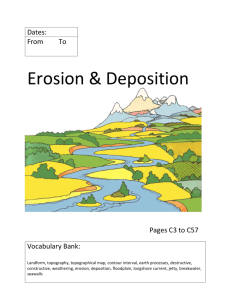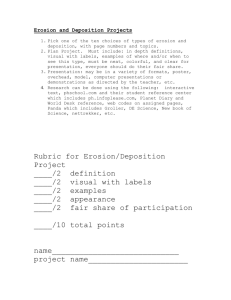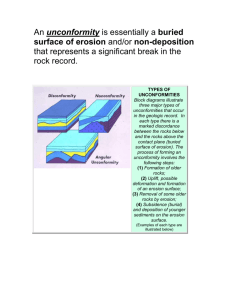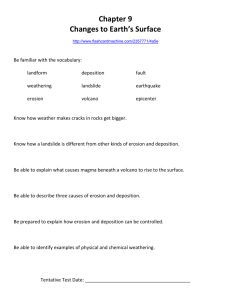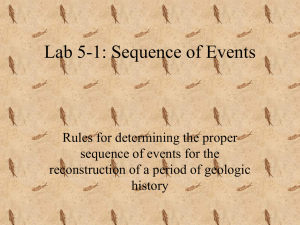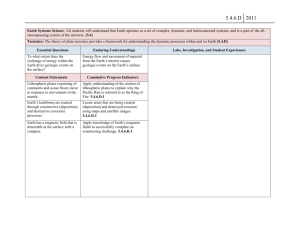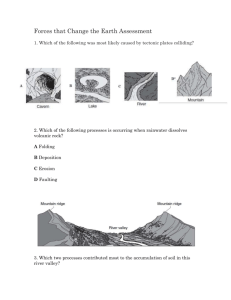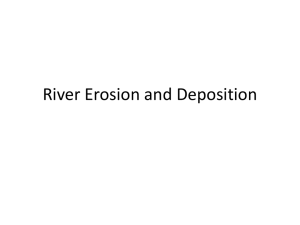Unconformities & Relative Dating: Geology Lecture Notes
advertisement
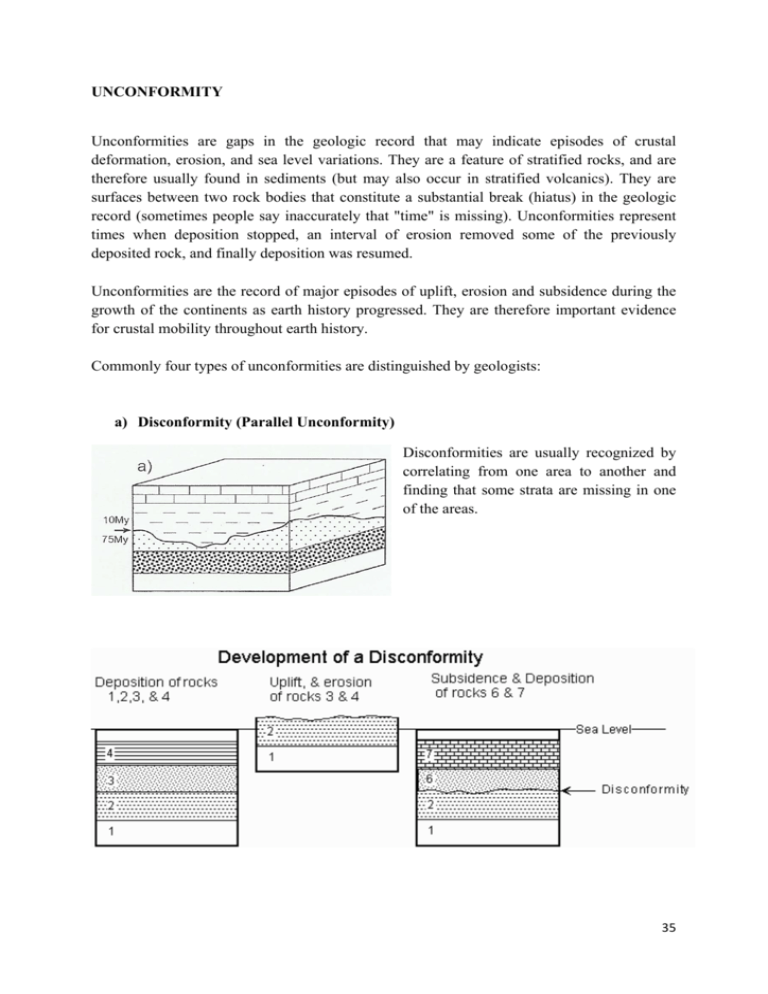
UNCONFORMITY Unconformities are gaps in the geologic record that may indicate episodes of crustal deformation, erosion, and sea level variations. They are a feature of stratified rocks, and are therefore usually found in sediments (but may also occur in stratified volcanics). They are surfaces between two rock bodies that constitute a substantial break (hiatus) in the geologic record (sometimes people say inaccurately that "time" is missing). Unconformities represent times when deposition stopped, an interval of erosion removed some of the previously deposited rock, and finally deposition was resumed. Unconformities are the record of major episodes of uplift, erosion and subsidence during the growth of the continents as earth history progressed. They are therefore important evidence for crustal mobility throughout earth history. Commonly four types of unconformities are distinguished by geologists: a) Disconformity (Parallel Unconformity) Disconformities are usually recognized by correlating from one area to another and finding that some strata are missing in one of the areas. 35 b) Angular Unconformity Angular unconformities are easy to recognize in the field because of the angular relationship of layers that were originally deposited horizontally. c) Nonconformity Nonconformities occur where rocks that formed deep in the Earth, such as intrusive igneous rocks or metamorphic rocks, are overlain by sedimentary rocks formed at the Earth's surface. The nonconformity can only occur if all of the rocks overlying the metamorphic or intrusive igneous rocks have been removed by erosion. 36 d) Paraconformity Paraconformities are widespread gaps in the geologic layers where there is essentially no irregular erosion of the surface at the gaps, hence the sedimentary layers below and above the gaps are parallel. As you consider paraconformities keep in mind two characteristics: a gap and parallel layers. Para means “near”, as in nearly conformable. An unconformity with no obvious erosion surface. There is a distinct gap in the fossil record. RELATIVE DATING Relative dating utilizes six fundamental principles to determine the relative age of a formation or event. Principle of Original Horizontality sedimentary beds deposited near horizontal Principle of Superposition layers young from bottom to top Principles of Lateral Continuity tapering, thinning near edges Principle of Cross-Cutting Relationships disrupted pattern is older than disruption truncation of older rock bodies Principles of Intrusive Relationships Principle of Fossil Succession principles of faunal succession concept of index fossil fossil assemblage 37 In the following figures, ages of units are A, B, C, D, E, F, G from oldest to youngest. 38 39 APPLICATIONS 1. Determine the relative sequence of events in the diagram below. Enter the letter of the rock unit or geologic structure in the proper Event sequence. The geologic events of tilting, folding and erosion do not have single letter labels. Type the word "tilting", "folding" or "erosion" in the proper position. Event 1 is the oldest event. Event 20 is the most recent or youngest event. 40 2. According to the geological map; a) Show the inclination of the valley bottom lines (IVBL) on the map. directions of the beds by writing the appropriate V-rules. Find the dip b) Draw the map symbols of the all beds on the map. c) Put all the beds in vertical order, from youngest to oldest. d) Draw the geological cross-section A-B and C-D (Vertical Scale: 1/10000). Dip values of the older series are 40°, younger series are 20° for A-B section, Dip values of the younger series are 15°, find the dip values of the older series for C-D section. 41 UNCONFORMITIES Representing times of nondeposition, erosion or both Paraconformity Disconformity Angular unconformity Nonconformity 1 Prof.Dr.Kadir Dirik Lecture Notes A simplified diagram showing the development of an unconformity and a hiatus. (a) Deposition began 12 million years ago (MYA) and continued more or less uninterrupted until 4 MYA. A 1-million-year episode of erosion occured, and during that time strata representing 2 million years of geologic time were eroded. Time of erosion Amount of rock removed by erosion 2 Prof.Dr.Kadir Dirik Ders Notları Prof.Dr.Kadir Dirik Lecture Notes (Monroe&Wicander, 2005) (c) A hiatus of 3 billion years exists between the the older strata and the starata that formed during arenewed episode of deposition that began 3 MYA. (d) The actual stratigraphic record. The unconformity is the surface separating the strata and represents a major break in our record of geologic time. DISCONFORMITY Uplift Deposition Disconcormity (Monroe&Wicander, 2005) Uplift and erosion Deposition 3 Prof.Dr.Kadir Dirik Lecture Notes ANGULAR UNCONFORMITY Deposition Angular unconformity (Monroe&Wicander, 2005) Uplift Erosion Uplift and tilting Deposition 4 Prof.Dr.Kadir Dirik Lecture Notes NONCONFORMITY Uplift Deposition Nonconformity (Monroe&Wicander, 2005) Uplift and erosion of overlying sediments Intrusion of magna 5 Prof.Dr.Kadir Dirik Lecture Notes (Monroe&Wicander, 2005) 6 Prof.Dr.Kadir Dirik Lecture Notes Deposition Prof.Dr.Kadir Dirik Lecture Notes 7 Uplift, tilting, and faulting Prof.Dr.Kadir Dirik Lecture Notes 8 Erosion 9 Prof.Dr.Kadir Dirik Lecture Notes Deposition Prof.Dr.Kadir Dirik Lecture Notes 10 Intrusion Prof.Dr.Kadir Dirik Lecture Notes 11 Uplift and erosion Prof.Dr.Kadir Dirik Lecture Notes 12 Deposition Prof.Dr.Kadir Dirik Lecture Notes 13 Intrusion Prof.Dr.Kadir Dirik Lecture Notes 14 Lava flow Prof.Dr.Kadir Dirik Lecture Notes 15 Deposition Prof.Dr.Kadir Dirik Lecture Notes 16 17 Prof.Dr.Kadir Dirik Lecture Notes 18 Prof.Dr.Kadir Dirik Lecture Notes
